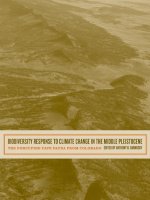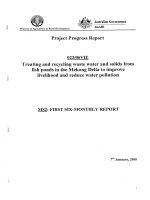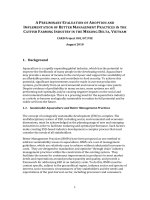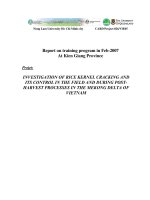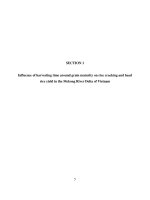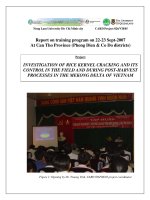Current and projected climate change in the Mekong Delta
Bạn đang xem bản rút gọn của tài liệu. Xem và tải ngay bản đầy đủ của tài liệu tại đây (3.65 MB, 5 trang )
Environmental Sciences | climatology
Current and projected climate
change in the Mekong Delta
Van Thang Nguyen*, Van Khiem Mai, Van Thang Vu, Dang Mau Nguyen
Vietnam Institute of Meteorology, Hydrology and Climate change
Received 10 May 2017; accepted 5 June 2017
Abstract:
This article evaluates trends in past and projected future climate change at
the Mekong Delta. The study is based on updated observation data gathered
up to 2014, and the latest climate change scenarios published by the Ministry
of Natural Resources and Environment (MONRE). The results show that
the mean annual temperature increased by 0.3 to 0.9oC, and annual rainfall
increased by 5 basis points to 20% at most observation stations during the
years 1958-2014. In comparison to the baseline (1986-2005), temperatures were
projected to increase by between 1.3 to 1.4°C in the middle of the century and
by between 1.7 to 1.9°C at the end of the century, under the medium scenario
(RCP4.5). According to the high scenario of RCP8.5, temperatures likely
increased by 1.8 to 2oC in the middle of the century and 3.4 to 3.6oC at the end
of the century. Annual rainfall is expected to increase from 10 to 20% in the
mid-21st century under both RCP4.5 and RCP8.5 scenarios; increase of 30% in
a part of the northern Mekong Delta under the RCP8.5 scenario.
Keywords: climate change, Mekong Delta, projected climate, rainfall,
temperature.
Classification number: 6.2
Introduction
The Mekong Delta is the largest
river delta in Vietnam, located in the
Mekong River Basin with a total natural
area of about 3.96 million ha. This
delta has a coastline ranging over 700
km, contiguous to Cambodia in the
northwest, to South Vietnam in the east,
to the East Sea in the northeast, to the
Pacific Ocean in the south, and to the
Gulf of Thailand in the west [1]. This
region is favourable to marine economic
development, exploitation, aquaculture,
and consumption and export. The
Mekong Delta is the largest agricultural
development area in the country,
contributing considerably to the region’s
total food production. However, due to
its low elevation and flat terrain, as well
as its location within tropical monsoon
climates, this area is vulnerable to
climate change [1].
In addition to this, freshwater
resources in the Mekong Delta are
strongly influenced by hydropower dams
in the Mekong River System, especially
during the dry season. Typically, severe
droughts and saltwater intrusion from
late 2015 to early 2016 in the Mekong
Delta was caused by a prolonged El
Nino phenomenon. According to the
Intergovernmental Panel on Climate
Change (IPCC), the Mekong Delta is
one of three deltas classified to have
extreme vulnerability of impact from sea
level rise caused by climate change; this
list also includes the Ganges River Delta
of the Brahmaputra River (Bangladesh)
and Nile River (Egypt) [2].
There have been a number of studies
*Corresponding author: Email:
92
Vietnam Journal of Science,
Technology and Engineering
June 2017 • Vol.59 Number 2
into the effects of climate change in the
Mekong Delta since the 1990s [3, 4].
In recent years, the assessment of the
impact of climate change, as well as
its consequences, has been investigated
by many authors [2, 5-15]. However,
most of these studies assess the impact
of climate change according to national
scales, and the Mekong Delta is the
only part of the assessments. In general,
most research is primarily based on
the IPCC’s Greenhouse Gas Emission
Scenario, published in 2007 [5, 6, 11,
12, 14]. In 2016, MONRE has updated
the impact assessment of climate change
and climate change projections at the
national scale based on updated data
(till 2014) and a new approach from
Representative Concentration Pathways
- RCPs announced by IPCC in 2013 [7].
The purpose of this study is to
calculate, analyse, and evaluate trends
in climate change ranging from the past
to projected impacts at the Mekong
Delta, based on the latest climate change
studies from MONRE and IPCC. This
study will update important information
about climate change for use to assess
the impact and vulnerability of the
Mekong Delta to climate change.
Data and methodology
Data
Observation data:
Observation data includes datasets of
climatic variables gathered from 19582014 at 11 stations in the Mekong Delta:
Moc Hoa, My Tho, Cao Lanh, Ba Tri,
Cang Long, Chau Doc, Can Tho, Soc
Trang, Rach Gia, Bac Lieu, and Ca Mau.
Model data:
The models used for constructing
climate change scenarios include: (i) the
AGCM/MRI model of Meteorological
Research Institute in Japan, (ii) the
PRECIS model of Met Office Hadley
Centre in UK, (iii) the CCAM model
of the Commonwealth Scientific and
Environmental Sciences | climatology
Industrial
Research
Organization
(CSIRO) in Australia, (iv) the RegCM
model of the Abdus Salam International
Centre for Theoretical Physics (ICTP)
in Italia, (v) and the clWRF
model of
s:
National Centers for Environmental
Prediction (NCEP) in USA. These
models were used to simulate the
regional climate in the baseline period
(1986-2005) and projected regional
climate at the middle (2046-2065),
and at the end (2080-2099) of the 21st
century (Table 1).
In this study, linear regression was
used to identify the trends in climate
variables during the period of 19612014. Linear regression of a predicted (y)
at time (t) can be described as follows:
y ao a1t
ao y a1 t , a1 ryt
sy
n
( yi y)2
i 1
, st
sy
st
n
(t t )
i 1
i
coefficient between y and t. The
increased and decreased trends of y(t)
are identified by the slope a1.
Climate change projections:
Projected climate change was
calculated based on the ensemble
method of 16 members derived from
16 models in Table 1. The variability of
variables was defined as follows:
- Determine the magnitude of
changes in temperature (oC):
2
In which
are means,
and
are s
Table 1. Models used
for constructing
climate
change scenarios.
No.
1
2
3
4
5
6
7
8
9
10
11
12
13
14
15
16
Models
GCMs
ACCESS1-0
CCSM4
CNRM-CM5
CCAM
GFDL-CM3
MPI-ESM-LR
NorESM1-M
ACCESS1-0
RegCM
NorESM1-M
Precis
HadGEM2-ES
GFDL-CM3
CNRM-CM5
CLWRF
NorESM1-M
MRI-20km_A NCAR-SST
MRI-20km_B HadGEM2- SST
MRI-20km_C GFDL - SST
MRI-20km_D
SST
Resolution
10 km
Baseline
- Determine the magnitude of
changes in rainfall (mm):
Available Data Period
RCP4.5 RCP6.0 RCP8.5
1970-2005 2006-2099
25 km
2046-2065
2080-2099
1960-2005 2006-2099
30 km
20 km
20 km
*
*
ÄTfuture =Tfuture
-T1986-2005
x
2006-2099
x
2046-2065
2080-2099
2006-2099
1980-2005 2006-2099
x
2006-2099
1984-2003
x
2080-2099
1980-2000
x
x
=
ÄR future
(R
*
future
R
*
-R1986-2005
*
1986-2005
) *100
In which: DTfuture is the difference
between future temperature and the
temperature taken at the baseline period
(oC), T*future is the future temperature
(oC), T*1986-2005 is the average temperature
of the baseline period (oC); DRfuture is the
difference between the rainfall in the
future and the rainfall at the baseline
period (%), R*future is the future rainfall
(mm), R*1986-2005 is the rainfall in the
baseline period (mm).
Results and discussions
x: No data.
Climate change in the past
Temperature:
Fig. 1. Observed trend of annual Fig. 2. Observed trend of annual
temperature (oC) during the period rainfall (%) during the period of
of 1961-2014.
1961-2014.
Methodology
Identify the trends of climate change
in the past:
In which y̅ , t̅ are means, and Sy,
St are standard deviations of y and
t, respectively; r is linear correlation
The annual average temperature had
an increasing trend across the Mekong
Delta, with increases of 0.3 to 0.9oC
during the period of 1958-2014. The
increasing trend in temperature at the
southern areas increased faster than
that of the areas in the north, except for
a portion in the northeast region of the
Mekong Delta (Fig. 1).
Rainfall:
Annual rainfall increased by 5 to
20% in the period from 1958 to 2014 in
the majority area of the Mekong Delta.
As well, there was a decrease of less
than 10% in rainfall over the southern
JUNE 2017 • Vol.59 Number 2
Vietnam Journal of Science,
Technology and Engineering
93
Environmental Sciences | climatology
region (Can Tho and Ca Mau, Fig. 2).
Climate extremes:
Daily maximum temperature (TXx)
has been seen to vary heterogeneously,
and some stations had a slightly increasing
trend, while others had a decreasing
trend (Soc Trang, Can Tho, Cao Lanh,
Rach Gia, and Ca Mau). In contrast,
daily minimum temperature (TNn)
increased at most of the stations, with
increases at a range from of 0.01°C/10
years (at My Tho station) to 1.36°C/10
years (at Chau Doc station). Along with
a decreasing trend at TXx, the number of
days with the high temperatures of over
35oC (SU35) decreased at most stations
in the Mekong Delta. Heavy rainfall
increased more than average rainfall. The
maximum 1-day rainfall (Rx1day), the
maximum 5-day rainfall (Rx5day), and
the number of days with precipitation
exceeding 95% (R95P) had increases in
most localities. Dry conditions appeared
more and more often, especially during
the dry season.
increases by 1.8 to 2.00C in the middle of
the century (Fig. 4A) and 3.4 to 3.60C at
the end of the century (Fig. 4B).
- Rainfall:
According to the RCP4.5 scenario:
When compared to the baseline period,
annual rainfall at the mid-21st century
will likely increase by 0 to 20% with
increases in rainfall over the Northern
Delta (e.g. Long An, Dong Thap, Tien
Giang, and Ben Tre, seen in Fig. 5A). At
the end of the 21st century, an increase in
rainfall is typically 10 to 20%; and the
Fig. 3. Projected changes in annual temperature (oC) for the middle (A) and
the end (B) of 21st century compared to the baseline period under RCP4.5
scenario from an ensemble of models.
Climate change projections
Changes in the mean values of
climate variables:
Changes in average temperature at
the middle and the end of the century,
in comparison to those of the baseline
period, are presented in Fig. 3 and 4. The
figures exhibit the most likely increases
in temperature across the whole Mekong
Delta. The increasing temperatures seen
in the provinces of the Mekong Delta are
quite similar to each other; however, the
increasing rate of temperatures is slightly
higher in the parts of the northeastern
and southern Mekong Delta.
Fig. 4. Projected changes in annual temperature (oC) for the middle (A) and
the end (B) of 21st century compared to the baseline period under RCP8.5
scenario from an ensemble of models.
- Temperature:
According to the RCP4.5 scenario,
the annual average temperature likely
increases by 1.3 to 1.40C in the middle
of the century (Fig. 3A) and 1.7 to 1.80C
at the end of the century (Fig. 3B) in
comparison to the baseline period.
Under the RCP8.5 scenario,
compared with the baseline period,
the annual average temperature likely
94
Vietnam Journal of Science,
Technology and Engineering
Fig. 5. Projected changes in annual rainfall (%) for the middle (A) and
the end (B) of 21st century compared to the baseline period under RCP4.5
scenario from an ensemble of models.
June 2017 • Vol.59 Number 2
Environmental Sciences | climatology
Northern provinces will have a higher
increase in rainfall (Fig. 5B).
According to the RCP8.5 scenario:
Compared to the baseline, rainfall in
the mid-21st century will likely increase
by 10-20% (Fig. 6A). By the end of the
21st century, annual rainfall will likely
increase higher than that of the midcentury, with a typical increase of 10 to
30% (Fig. 6B).
Changes in climate extremes:
- Extreme temperature:
Changes in average maximum
temperature at the end of the 21st century:
Fig. 6. Projected changes in annual rainfall (%) for the middle (A) and
the end (B) of 21st century compared to the baseline period under RCP8.5
scenario from an ensemble of models.
Compared to the baseline period, the
average maximum temperature will
likely increase by 1.8 to 2oC as seen with
the RCP4.5 scenario (Fig. 7A), and by
3.5 to 3.8o C as seen with the RCP8.5
scenario (Fig. 7B). Accompanied with
an increase of maximum temperature,
the number of hot days is likely to
increase by 10 to 20 days as predicted by
the RCP4.5 scenario or by 20 to 40 days
as based on the RCP8.5 scenario by the
end of the 21st century.
Change in average minimum
temperature at the end of the 21st century:
Compared to the baseline period, the
average minimum temperature will
likely increase by 1.8 to 1.9oC as seen
with the RCP4.5 scenario (Fig. 8A) and
by 3.4 to 3.6oC as seen with the RCP8.5
scenario (Fig. 8B).
- Extreme rainfall:
Compared to the baseline, the
maximum 1-day rainfall (Rx1day) and
the maximum 5-day rainfall (Rx5day)
are expected to increase in the future.
According to the RCP4.5 and RCP8.5
scenarios, Rx1day increased by 10 to
Fig. 7. Projected changes in annual mean maximum temperature (oC) for the
end of 21st century compared to the baseline period according to RCP4.5 (A)
and RCP8.5 (B) scenarios from an ensemble of models.
Fig. 8. Projected changes in annual mean minimum temperature (oC) for the
end of 21st century compared to the baseline period according to RCP4.5 (A)
and RCP8.5 (B) scenarios from an ensemble of models.
Fig. 9. Projected changes in Rx1day (mm)
for the end of 21st century compared to
the baseline period according to RCP4.5
(A) and RCP8.5 (B) scenarios from an
ensemble of models.
JUNE 2017 • Vol.59 Number 2
Vietnam Journal of Science,
Technology and Engineering
95
Environmental Sciences | climatology
[5] MONRE (2009), Scenario of climate
change and sea level rise for Vietnam, Vietnam
Publishing House of Natural Resources,
Environment and Cartography (NARENCA).
[6] MONRE (2012), Scenario of climate
change and sea level rise for Vietnam,
NARENCA.
[7] MONRE (2016), Scenario of climate
change and sea level rise for Vietnam,
NARENCA.
Fig. 10. Projected changes in Rx5day(mm) for the end of 21st century
compared to the baseline period according to RCP4.5 (A) and RCP8.5 (B)
scenarios from an ensemble of models.
40% and Rx5day increased by 20 to over
40% (Fig. 9 and 10) by the end of the 21st
century.
Conclusions
This study presents the results of
an assessment of past and projected
impacts of climate on the Mekong Delta,
based on updated data (up to 2014) and
the latest climate change scenarios from
the MONRE; the results show that:
1) The indicators of climate change
in the Mekong Delta:
The annual average temperature
in the Mekong Delta Region increased
during the period of 1958-2014, with a
typical increase within a range of 0.3
to 0.9oC. In which, the temperature
increased higher in localities such as
Long An, Hau Giang, Bac Lieu, Ca Mau,
and Phu Quoc. Minimum temperature
has obviously increasing trends at most
stations.
Annual rainfall increased by 5-20%
in most provinces of the Mekong Delta
during the period of 1958-2014.
2) Climate change projections:
- Temperature: According to the
RCP4.5 scenario, the average annual
temperature will likely increase by 1.3 to
1.4°C in the mid-21st century and by 1.7
to 1.9°C at the end of the 21st century.
According to the RCP8.5 scenario, the
average annual temperature will likely
96
Vietnam Journal of Science,
Technology and Engineering
increase by 1.8 to 2oC in the mid-21st
century and 3.4 to 3.6 at the end of the
21st century. The average maximum
temperature increases higher than the
average minimum temperature and
the increasing trend gradually reduces
from northern to southern regions of the
Mekong Delta.
- Rainfall: When compared to the
baseline period, rainfall based on RCPs
(RCP4.5 and RCP8.5) likely increases by
5 to 15% at the middle and at the end of
the 21st century, in which the increase in
the North is higher than in the Southern
Delta. At the end of the century, Rx1day
increased by 10 to 40%, while Rx5day
increased by 20 to over 40%.
REFERENCES
[1] Vietnam Institute of Meteorology,
Hydrology and Environment (2010), Impacts
of climate change on water resources and
adaptation measures in Mekong Delta, Project
final report.
[2] IPCC (2007), Climate change 2007:
The Scientific basis, contribution of working
group I to the fourth assessment report of the
Intergovernmental Panel on Climate Change,
Cambridge University Press, United Kingdom
and New York, NY, USA.
[3] Duc Ngu Nguyen, Trong Hieu Nguyen
(1991), Climate change and their impacts
in Vietnam for past 100 years - Natural and
human, Truth Publishing House, Hanoi.
[4] Duc Ngu Nguyen, Trong Hieu Nguyen
(1999), The status of climate change in
Vietnam for next decades, Vietnam Institute of
Meteorology and Hydrology.
June 2017 • Vol.59 Number 2
[8] Duc Thanh Ngo, Van Tan Phan (2012),
“Non-parametric test for trend detection of
some meteorological elements for the period
1961-2007”, Journal of Science, Vietnam
National University, Hanoi, 28(3S), pp.129135.
[9] Duc Ngu Nguyen - Chief author
(2008), Climate change, Science and Technics
Publishing House, Hanoi.
[10] Nguyen Van Thang, et al. (2015),
Changes in climate extremes and impacts on
the natural physical environment, NARENCA,
pp.84-139.
[11] Van Thang Nguyen, et al. (2010),
Study the effects of climate change on
natural conditions, natural resources and
propose strategic solutions for prevention,
mitigation and adaptation for sustainable
socio-economic development in Vietnam,
Final report KC08.13/06-10, Vietnam Institute
of Meteorology, Hydrology and Environment,
Hanoi, 330 pages.
[12] Van Thang Nguyen, et al. (2013),
“Climate change in Mekong Delta and
adaptations”, Journal of Science, Vietnam
National University, Hanoi, 2S, pp.187-194.
[13] Van Thang Nguyen, et al. (2017),
“Changes in climate extreme in Vietnam”,
Vietnam Science and Technology, 1(1), pp.7987.
[14] Van Tan Phan, et al. (2010), Study the
impacts of global climate change on climate
extreme factors and events in Vietnam,
predictability and strategic response, Final
report KC08.29/06-10.
[15] Thanh Hang Vu, Thi Thu Huong Chu,
Van Tan Phan (2009), “Trend of maximum
daily rainfall in Vietnam during 19612007”, Journal of Science, Vietnam National
University, Hanoi, 25(3S), pp.423-430.

